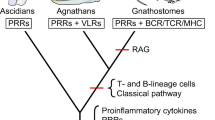Abstract
THE immune response of vertebrate species seems initially to involve recognition events between immunogenic molecules and specific lymphocyte receptors. These recognition events subsequently result in amplification steps including, in many cases, increases in cells capable of producing humoral antibodies or participating in cell mediated reactions1. Since invertebrates apparently cannot make humoral antibodies2,3 but can reject allografts4,5 it seems appropriate to inquire if such animals have receptors capable of discriminating self from non-self. The similarities between antigen receptors and humoral antibodies in vertebrates6,7 serve as additional reasons for investigating recognition mechanisms in invertebrates. Although sufficient data exist to indicate that the lectin-like agglutinins present in haemolymph can function as opsonins for foreign erythrocytes in certain invertebrates8, considerations of foreignness of protein molecules are not as definitive. Certain crustaceans, such as crayfish9 and lobsters10, can readily clear certain mammalian serum albumins from the circulation but little is known of the specificity of this elimination. We have investigated whether crustaceans possess recognition molecules (referred to as receptors) enabling them to recognise various proteins as foreign and to eliminate these proteins from the circulation. The basic premise was that if such receptors are present, regardless of their location (cell-bound or free), they should be of finite number (and thus saturable) and have some discernable degree of specificity.
Similar content being viewed by others
References
Jerne, N. K., Cold Spring Harb. Symp. quant. Biol., 23, (1967).
Bang, F., Bioscience, 23, 584 (1973).
Shapiro, H., Am. Zool., 15, 13 (1975).
Cooper, E., Transplant. Proc., 2, 216 (1970).
Duprat, P., Transplant. Proc., 2, 222 (1970).
Uhr, J., and Vitetta, E., Fedn Proc., 32, 35 (1973).
Marchalonis, J., and Cone, R., Transplant. Rev., 14, 3 (1973).
McKay, D., and Jenken, C., Aust. J. exp. Biol. med. Sci., 48, 139 (1970).
Teague, P., and Friou, G., Comp. Biochem. Physiol., 12, 471 (1964).
Stewart, J., and Foley, D., J. Fish. Res. Bd Can., 26, 1392 (1969).
McConahey, P., and Dixon, F., Int. Arch. Allerg., 29, 185 (1966).
Burnet, F., Nature, 218, 426 (1968).
Author information
Authors and Affiliations
Rights and permissions
About this article
Cite this article
SLOAN, B., YOCUM, C. & CLEM, L. Recognition of self from non-self in crustaceans. Nature 258, 521–523 (1975). https://doi.org/10.1038/258521a0
Received:
Accepted:
Issue Date:
DOI: https://doi.org/10.1038/258521a0
- Springer Nature Limited
This article is cited by
-
Host-parasite interactions: a study on the pathogenicity of different Mesanophrys sp. densities and hemocytes-mediated parasitic resistance of swimming crabs (Portunus trituberculatus)
Parasitology Research (2024)
-
Discriminative ability and function of the immunobiological recognition system of the snailHelix pomatia
Journal of Comparative Physiology ? B (1981)
-
Bahavioral fever in crayfish
Hydrobiologia (1977)





